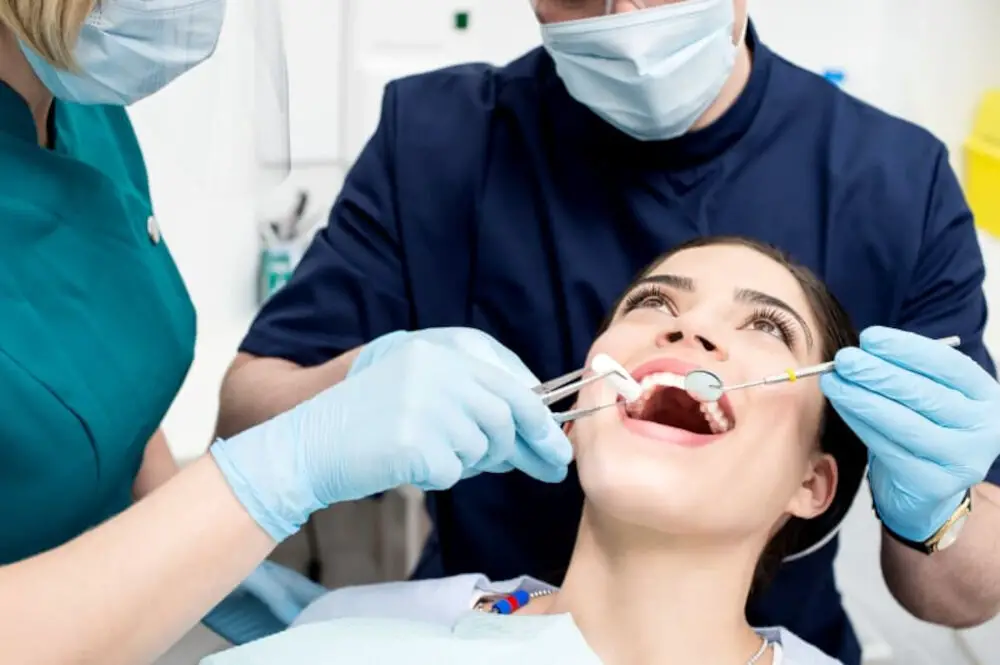Post Wisdom Teeth Extraction: When is it Safe to Use a Straw?

Wisdom teeth extraction is a common dental procedure that many people undergo. While the procedure itself is routine, the post-operative phase can be a bit tricky, especially when it comes to what you can and cannot do. One of the most common questions that people have after getting their wisdom teeth removed is when it is safe to use a straw. While it may seem like a simple question, the answer is not always straightforward. In this article, we will explore the topic of post-wisdom teeth extraction and the use of straws, discussing when it is safe to use a straw and when it is best to avoid them. When it comes to oral surgery, it is essential to follow the post-operative instructions provided by your dentist or oral surgeon. These instructions are designed to help you heal properly and avoid any complications that may arise. One of the most critical post-operative instructions is to avoid using a straw for a certain period. The reason for this is that the sucking motion required to use a straw can create a vacuum in the mouth, which can cause the blood clot that forms at the extraction site to dislodge. This can lead to a painful condition called dry socket, which can delay the healing process.
Wisdom teeth extraction is a common dental procedure that involves removing the third molars, located at the back of the mouth. This is typically done due to overcrowding or impaction, which can lead to pain, swelling, and infection. After the extraction, patients are advised to avoid using straws for the first few days, as the suction created by the straw can dislodge the blood clot that forms over the extraction site. This can lead to a painful condition called dry socket, which delays the healing process and requires additional treatment. As such, it is important to follow your dentist’s post-operative instructions carefully to ensure a smooth and speedy recovery.
The Healing Process

The healing process of wisdom teeth extraction can be a daunting experience for many individuals. After the surgery, it is crucial to follow the post-operative instructions given by the dentist to ensure proper healing. The first 24 hours are critical as the blood clot forms in the socket, which is essential for the healing process. Any disruption of the blood clot can lead to a painful condition known as dry socket. Therefore, it is recommended to avoid smoking, spitting, or using a straw for the first few days after the surgery. The healing process can take up to two weeks, during which time the patient may experience swelling, discomfort, and soreness. It is essential to take prescribed medications as directed by the dentist to manage pain and prevent infection. It is also crucial to maintain good oral hygiene by gently brushing and rinsing the mouth with warm saltwater. As the healing progresses, the patient can gradually resume normal activities like eating solid foods and drinking liquids with a straw, but only after the dentist gives the green light. With proper care and attention, the healing process can be smooth and successful, and the patient can enjoy a healthy and pain-free mouth.
After wisdom teeth extraction, the healing process starts with the formation of a blood clot in the socket. This clot acts as a protective barrier against bacteria and debris, while also promoting the growth of new tissue and bone. Over the next few days, the area may be swollen and tender, and patients may experience some bleeding and discomfort. However, with proper care and rest, the body will gradually heal itself, and the gums will close up around the socket. It’s important to avoid drinking through a straw or smoking during this time, as the suction can dislodge the clot and delay healing. Patients should also eat soft foods, use ice packs to reduce swelling, and take any prescribed pain medication as directed.
After a wisdom teeth extraction, it is crucial to take proper care of the mouth to avoid any complications. One of the most common questions that arise is when it is safe to resume certain activities such as using a straw. Typically, it is recommended to wait at least 24 hours before using a straw to avoid dislodging the blood clot that forms in the socket. However, the timeline may vary depending on the individual’s healing process and the complexity of the extraction. It is best to consult with the dentist or oral surgeon for specific guidelines on when to resume certain activities. Following the appropriate timeline and guidelines can aid in a successful recovery and prevent any further complications.
Risks of Using a Straw

Using a straw may seem like a harmless activity, but it can actually pose several risks, especially after wisdom teeth extraction. One of the main risks of using a straw after dental surgery is the development of a dry socket. A dry socket occurs when the blood clot that forms in the socket after a tooth extraction becomes dislodged or dissolves, leaving the bone and nerves exposed. Using a straw creates suction in the mouth, which can dislodge the blood clot and delay the healing process. This can lead to increased pain, swelling, and the need for further treatment. Another risk of using a straw after wisdom teeth extraction is the introduction of bacteria into the healing socket. Straws can harbor bacteria and other pathogens, which can be introduced into the mouth during use. This can increase the risk of infection and slow down the healing process. Additionally, using a straw requires the mouth to be open for an extended period of time, which can create a breeding ground for bacteria and other pathogens to thrive. Therefore, it is recommended to avoid using a straw for at least a week after wisdom teeth extraction to reduce the risk of complications and promote proper healing.
Using a straw after wisdom teeth extraction can pose several risks that could potentially delay the healing process. Firstly, the suction created by the straw can dislodge the blood clot that forms in the socket, which is essential for proper healing. This can lead to a painful condition known as dry socket, where the bone and nerve endings become exposed. Additionally, the force required to create suction while using a straw can cause irritation and damage to the sensitive tissues in the socket. The risk of infection also increases when using a straw because bacteria can be introduced into the socket through the straw. Overall, it is crucial to avoid using a straw for at least a week after wisdom teeth extraction to ensure a smooth and speedy recovery.
Dry socket is a painful complication that can occur after wisdom teeth extraction. It is a condition where the blood clot that forms in the socket where the tooth was removed dislodges or dissolves, leaving the bone and nerves exposed. This can cause severe pain, bad breath, and an unpleasant taste in the mouth. Using a straw after wisdom teeth extraction can increase the risk of developing dry socket. The suction created by drinking through a straw can dislodge the blood clot, slowing down the healing process and leading to dry socket. Therefore, it is important to avoid using a straw for at least one week after the procedure and follow the post-operative instructions provided by the dentist to minimize the risk of complications.
When it is Safe to Use a Straw

After a wisdom teeth extraction, it’s important to take care of your mouth and avoid any activities that could cause further damage or delay the healing process. One of the most common questions patients have is when it is safe to use a straw. While using a straw may seem like a harmless activity, it can actually put a lot of pressure on the surgical site and potentially dislodge the blood clot that forms to protect the wound. This can lead to a painful condition called dry socket, where the underlying bone and nerves are exposed. Typically, dentists recommend waiting at least 24 hours after the procedure before using a straw. This allows enough time for the blood clot to form and stabilize, reducing the risk of complications. However, your dentist may provide specific instructions based on the severity of your extraction and your individual healing process. It’s important to follow these instructions closely to ensure that you heal properly and avoid any unnecessary pain or complications. In general, it’s always better to err on the side of caution and avoid using a straw until you have received clearance from your dentist.
After wisdom teeth extraction, it is crucial to follow the post-operative instructions provided by the dentist or oral surgeon to avoid complications. Among the many restrictions, patients are often advised to avoid using a straw for a few days. The reason behind this is that sucking through a straw creates negative pressure in the mouth, which can cause the blood clot that forms in the empty socket to dislodge, leading to a painful condition called dry socket. Typically, it is safe to use a straw after the first three to four days of the surgery, when the blood clot has formed and is stable enough to withstand the suction pressure. However, it is best to consult with the treating dentist or oral surgeon to get personalized advice on when it is safe to use a straw after wisdom teeth extraction.
Consulting with a dentist or oral surgeon before using a straw is crucial after wisdom teeth extraction. The extraction process can leave the gums vulnerable to infections, dry sockets, and bleeding. Using straws can create negative pressure in the mouth, which can dislodge the blood clot formed over the extraction site, leading to severe pain and delay in the healing process. Consulting a dentist or oral surgeon can help determine when it is safe to use a straw and avoid any potential complications. Furthermore, they can provide valuable advice on proper oral care and medication, minimizing the risk of any postoperative complications. It is essential to take care of the extraction site to ensure a speedy and successful healing process.
Alternatives to Straws

When it comes to post wisdom teeth extraction recovery, using a straw can be detrimental to the healing process. The suction created by sucking on a straw can dislodge the blood clot that forms in the socket where the tooth was extracted, leading to a painful condition called dry socket. However, there are plenty of alternatives to straws that can be used during this recovery period. One option is to simply drink from a cup or glass without the use of a straw. This is the safest and easiest way to avoid any complications and ensure that the healing process is not disrupted. Additionally, using a spoon to sip on liquids can provide a similar experience to using a straw without the risk of suction. Another alternative to using a straw during post wisdom teeth extraction recovery is to use a reusable silicone or metal straw. These types of straws do not create the same amount of suction as a plastic straw and are also more eco-friendly. Additionally, silicone and metal straws are easy to clean and can be used over and over again, reducing waste. Some people may also find that using a straw with a wider diameter, such as a smoothie straw, can also reduce suction and be less harmful to the healing process. Overall, there are plenty of alternatives to using a straw during post wisdom teeth extraction recovery, and it is important to choose one that is safe and effective for your individual healing process.
After wisdom teeth extraction, it is important to avoid drinking through a straw as the suction can dislodge the blood clot and delay the healing process. However, there are alternative methods for drinking that can be used instead. One method is to drink from a cup or glass and sip slowly, taking care not to swish the liquid around in the mouth. Another option is to use a spoon to gently scoop the liquid into the mouth. It is also recommended to avoid hot liquids as they can increase swelling and pain, and to stick to cool or room temperature liquids. By following these alternative methods, patients can ensure a smooth and speedy recovery after wisdom teeth extraction.
If you’ve recently had your wisdom teeth removed and are wondering when it is safe to use a straw, it’s important to know that using a straw can potentially dislodge the blood clot that forms over the extraction site, leading to complications and prolonging the healing process. However, there are tips for making drinking easier without a straw. You can use a small spoon to sip liquids, tilt your head back slightly while drinking, or try drinking from the opposite side of your mouth. You can also opt for soft foods and beverages, such as smoothies, soups, or tea, which require less effort to consume. By following these tips, you can stay hydrated and nourished while allowing your mouth to heal properly.
After wisdom teeth extraction, it is important to follow a strict set of guidelines to ensure proper healing and avoid complications. One of the most commonly asked questions is when it is safe to use a straw. Generally, it is recommended to wait at least 24-48 hours before using a straw to avoid dislodging the blood clot that forms over the extraction site. This blood clot is crucial for the healing process and should not be disturbed. It is also important to avoid smoking, spitting, and drinking hot beverages during this time. Following these guidelines and consulting with a dental professional can help ensure a smooth recovery after wisdom teeth extraction.
As you recover from wisdom teeth extraction, it is important to follow your dentist’s instructions carefully to ensure a smooth and successful recovery. Avoid using straws, smoking or vigorously rinsing your mouth for at least 24-48 hours after the procedure, as these activities can dislodge the blood clot and delay the healing process. Pain, swelling and bleeding are common after tooth extraction, but they can be managed with painkillers and ice packs. Make sure to eat soft, nutritious foods and drink plenty of fluids to stay hydrated. Rest as much as possible and avoid strenuous activities for a few days. If you experience fever, severe pain or bleeding, contact your dentist immediately. With proper care and patience, you can recover from wisdom teeth extraction and enjoy good oral health.
Conclusion

In conclusion, post wisdom teeth extraction, it is imperative to follow the necessary precautions to avoid any complications. Using a straw may seem like a harmless act, but it can lead to painful dry sockets and delay the healing process. It’s best to avoid straws for at least the first few days after the surgery and stick to soft foods and a gentle oral hygiene routine. It’s crucial to listen to your dentist’s instructions and take care of yourself to ensure a smooth recovery. Remember that patience is key, and allowing your body to heal at its own pace is essential for a successful recovery.







